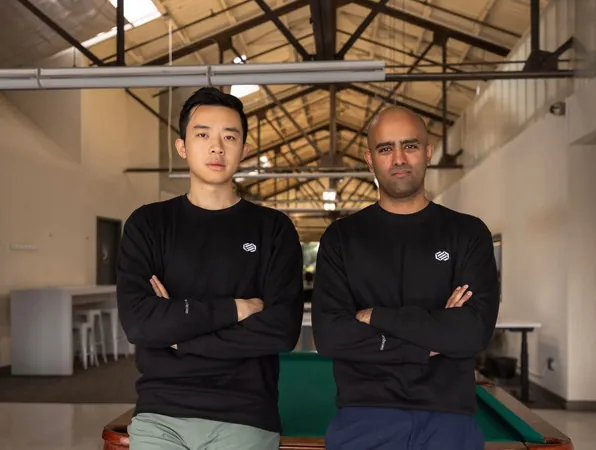
Revolutionary SuperLimbs: The Game-Changer for Astronauts on the Moon!
2024-10-14
Author: Wai
Introduction
Humans haven't set foot on the moon since NASA's iconic Apollo missions wrapped up in 1972, but this will soon change with the ambitious Artemis program, which is set to return astronauts to lunar soil as early as 2026. The Artemis missions aim not only to land astronauts on the surface but also to create a sustainable human presence by building a habitable base and exploring the moon's mysterious, heavily cratered south pole.
Innovative Safety Solution
In this quest for lunar exploration, innovative minds around the globe are working tirelessly to ensure astronaut safety, including researchers at the prestigious Massachusetts Institute of Technology (MIT). They are developing an exciting solution known as “SuperLimbs,” wearable robotic limbs designed to assist astronauts in recovering from falls—a critical concern given the moon's unique gravitational environment.
How SuperLimbs Work
The concept of SuperLimbs involves a set of robotic arms that extend from a backpack equipped with life support systems. Should an astronaut lose their balance and fall, these robotic limbs come to the rescue, providing the necessary leverage to help them stand up again—saving precious energy for other important tasks.
Context and Need
This innovation is particularly relevant in light of a study from the University of Michigan, which revealed that Apollo astronauts experienced 27 falls and faced 21 near misses during their moonwalks. The challenges of moon walking are compounded by its partial gravity, making balance tricky. Notably, in 1972, astronaut Charlie Duke had difficulty getting back up after falling during soil tests, illustrating the importance of this technology.
Getting Ahead with SuperLimbs
The development of SuperLimbs has been in the works for around a decade, led by MIT professor Harry Asada. Originally tested by workers in industries such as aircraft manufacturing and shipbuilding, the technology is now being adapted specifically for use in space. Erik Ballesteros, a doctoral student at MIT, recently spent the summer at NASA's Jet Propulsion Laboratory (JPL) honing the SuperLimbs design under a NASA fellowship.
Ballesteros states that while there is still work to be done, he anticipates a demonstration involving a mannequin by January. He foresees that human tests will take place within the next couple of years, as precise safety measures have to be considered. “We can’t just duct tape and throw things together; we have to be very precise and very careful,” he explained.
Challenges in Implementation
However, implementing such technology in space is not without challenges. Dr. Jonathan Clark, an expert in Neurology and Space Medicine, highlighted that the extreme conditions of space—including temperature extremes, harmful space dust, and radiation—create hurdles for technology approval. Yet, he remains optimistic about the pace of innovation in the sector. “For science fiction to go to science fact, it used to take centuries or decades. Now it’s years,” he noted.
The Stakes Are High
Understanding the importance of this technology, Ballesteros draws on his experience at NASA’s Johnson Space Center, where he helped manage life support systems for the International Space Station. Aeronautics expert Ana Diaz Artiles added that while SuperLimbs could reduce the metabolic cost of standing up after a fall, they may also present challenges, including added weight and energy requirements.
Moreover, the lunar surface might prove problematic as the dust encountered there is considered "super toxic." SuperLimbs could potentially mitigate the risk of astronauts rolling around in hazardous dust while they try to regain balance.
The Future of Lunar Exploration
As humans prepare for longer missions on the moon—up to a week at a time, compared to the brief hours logged during Apollo missions—the demand for innovative solutions like SuperLimbs is greater than ever. Artemis astronauts will be tasked with valuable scientific research, paving the way for eventual manned missions to Mars. Meanwhile, global competitors like China are racing to establish their lunar presence by 2030.
Ballesteros envisions the future of SuperLimbs as multi-functional tools, akin to a “Swiss Army Knife” that can serve various uses while maintaining a unified design. He plans to enhance the limbs further, turning them into an additional set of legs to increase mobility and energy efficiency. He aims for astronauts to experience these limbs as a natural extension of their bodies, making it feel odd not to have them during missions.
In his vision, SuperLimbs will redefine the astronaut experience, establishing a new paradigm for space travelers. Expect a more agile, safe, and efficient future for lunar explorers—thanks to SuperLimbs!
Conclusion
Stay tuned for more updates on this groundbreaking technology and the future of lunar exploration!




 Brasil (PT)
Brasil (PT)
 Canada (EN)
Canada (EN)
 Chile (ES)
Chile (ES)
 España (ES)
España (ES)
 France (FR)
France (FR)
 Hong Kong (EN)
Hong Kong (EN)
 Italia (IT)
Italia (IT)
 日本 (JA)
日本 (JA)
 Magyarország (HU)
Magyarország (HU)
 Norge (NO)
Norge (NO)
 Polska (PL)
Polska (PL)
 Schweiz (DE)
Schweiz (DE)
 Singapore (EN)
Singapore (EN)
 Sverige (SV)
Sverige (SV)
 Suomi (FI)
Suomi (FI)
 Türkiye (TR)
Türkiye (TR)